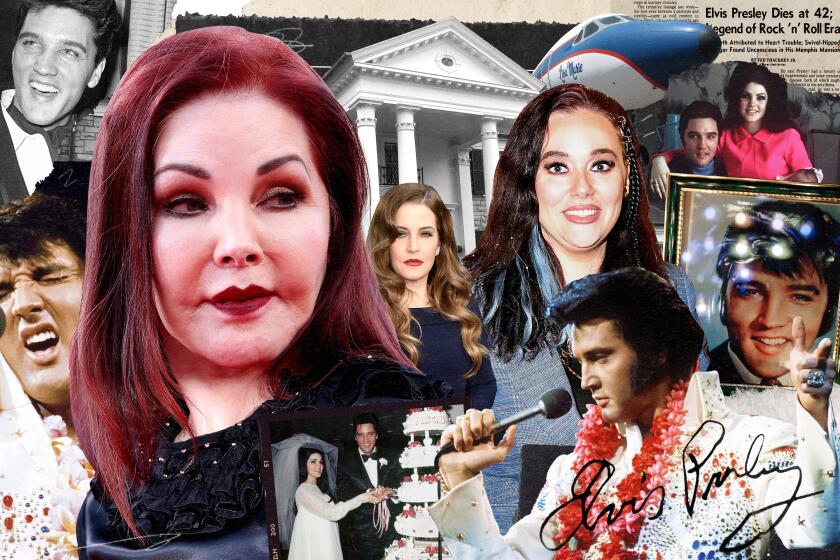How the animation studio behind ‘Big Mouth’ and ‘Star Trek: Lower Decks’ stays independent

- Share via
It’s hard to say what exactly defines the kind of irreverent animated TV show Titmouse makes. But you kind of know one when you see one.
The L.A.-based studio, founded 25 years ago by husband-and-wife team Chris and Shannon Prynoski, is responsible for a wide variety of cartoon hits: “Metalocalypse,” the stoner-friendly Adult Swim death metal cult comedy that helped put them on the map; Netflix’s “Big Mouth,” which debuted its eighth and final season this year; and “Star Trek: Lower Decks” for Paramount+.
As the animation industry has gone through massive up-and-down swings, including the streaming wars and their brutal aftermath, the company’s leaders say they’ve weathered the challenges and expanded their audience by staying independent.
That has allowed them to experiment with new ideas.
“It’s still a job, but we’re a little more masters of our own domain,” said Chris Prynoski in a recent video interview. “We can take a big risk and move fast.”
Titmouse is launching a Dungeons & Dragons-esque table-top drinking and role-playing game, in addition to a merch and collectibles delivery box service called Churp, lines of business that echo the company’s origins as a side project selling T-shirts. It turned its Hollywood warehouse into a black box theater to host live events.
Titmouse has more than 700 employees — with offices in Los Angeles, New York and Vancouver — down from the streaming highs but still considerable. The company expanded its L.A. footprint to Burbank several years ago.
The bold bets continue on the animation side as well, including on the acclaimed science-fiction series “Scavengers Reign” (canceled at Max after one season). Prynoski points to a popular episode the company animated for the recent season of Blur Studio’s Netflix anthology series “Love Death + Robots.” The episode, “How Zeke Got Religion,” follows a World War II bomber crew that encounters a demonic enemy during an attack on the Nazis.
“We don’t have a house style, but we have a bit of a house sensibility,” Prynoski said. “It’s just finding that thing in there, and it could be anything, but a lot of it is tone, comedy or being able to animate it really well — something that feels like we can be additive and make it better.”
This interview was edited for length and clarity.
The animation business has been through numerous boom and bust cycles. Where is it now?
Chris Prynoski, president and founder: When I graduated in ‘94 there were, like, three adult animated shows, and that was considered a boom. And now, if there were three shows, it would be considered like a tragedy, right? So I think it’s kind of back to like average, or slightly above average, as opposed to like three or four years ago, where it was so incredibly crazily above average that we knew it wasn’t gonna last forever.
Ben Kalina, chief operating officer: We look at the number of shows that we have, and right now it feels very similar to 2018 or 2019. At that time, we were like, “This is a lot of work.” Then 2020 was a noticeable increase, and ‘21 was through the roof in terms of the number of projects happening. If you talk to people in video games or live action, I think they’re experiencing the same thing.
Shannon Prynoski, co-founder and vice president: The streaming platforms were really new. Netflix needed stuff. Hulu. Amazon. They all came out and they all needed content, and now they’re all coming down.
Have you had offers to acquire Titmouse, or invest in it?
C.P.: All the time. Depending on who it’s coming from and what it is, we’ll consider it. We just haven’t ever pulled the trigger. Maybe someday, who knows. But not yet.
So you’ve never taken outside funding, other than crowdfunding for certain individual projects? How did you grow the company?
C.P.: We were a married couple that was living in a small apartment. Our apartment was $800 a month, so we didn’t have to make a lot of money and we could take risks, and we took some big swings back then when, frankly, I didn’t know any better.
S.P.: I had to learn about business loans and stuff like that. I was able to get an SBA loan and figure that out.
What was one of the biggest swings?
C.P.: When I started, I knew I didn’t know anything about business. Shannon convinced me to quit my gig at Cartoon Network, where I was a showrunner, and man, you just don’t quit those kinds of jobs. But she was like, “Hey, if you quit that and focus on Titmouse, that will be how we make a living.” So that was a big swing.
What show was your big break?
C.P.: “Metalocalypse” was the thing that really established us. Having worked on other shows, like “Daria” and “Beavis and Butt-Head,” you kind of know when a show has that feeling and that vibe, like, this could very well be a hit. And it worked out really well that that was our first series.
S.P.: Everyone had to roll their sleeves up and do everything. We all did multiple tasks because that’s how it was. But I think when we got “Turbo FAST” and “Motorcity,” those really started to elevate us.
C.P.: “Motorcity” was a big one. We’d been doing shows for Adult Swim, MTV and BET and the smaller cable networks, and we would have been fine staying in that lane. But then I sold “Motorcity” to Disney, and based on that, we did “Randy Cunningham: 9th Grade Ninja,” and that attracted the attention of the other bigger players. Then DreamWorks Animation did their big deal with Netflix, and we got a considerable amount of work with them.
B.K.: Netflix stepping up their animation production was obviously big. “Big Mouth” was a big step up for us, because we’d been doing a lot of adult-oriented content, but we hadn’t tapped into the broader prime-time-style comedy.
Did “Big Mouth” feel like it was going to be a game changer for you when it first came through the door?
C.P.: Not initially. I knew it was going to be funny. And I thought I knew what it was going to be — like an even dirty version of “Family Guy.” That was my perception. But when I first started going to the table reads, I was like, “This show is going to be much, much more than dick jokes. There’s something deeper and better.”
S.P.: Netflix really promoted it too.
C.P: It was a good time that we kind of hit, because they wanted to get more into this space, so they were willing to really market stuff in a way that is rare now that they have so many shows.
When I think of Titmouse shows, I think of a lot of the guys I knew in college who were into video games, weed, heavy metal, “Star Wars” and “Star Trek.” Has the audience expanded beyond that?
S.P.: I think it has. “Jentry Chau vs. The Underworld” was a great show about a female character, and we’re doing a lot more female-run shows. Networks are opening up and saying, “Oh, men and women will both watch these shows,” and that’s been really helpful. And a lot of women are animating now, so it’s a lot broader.
People may not realize you’ve done some preschool material too, with “Frog and Toad” on Apple TV+, for example, which is a coincidence because my kid is obsessed with those books.
C.P.: There’s an interesting story with “Frog and Toad.” When you’re developing the show, there’s all the material from the books, but you have to expand it out. So the art director on that show did all the research on the area where the author grew up, and found that all the flora from the books was local. So they decided to research and only draw the plant life and vegetation from that area.
What’s the biggest risk out there for you? Is it AI?
C.P.: This industry is full of risks. If you’re looking for something safe, don’t get into entertainment. It’s not a blue-chip stock. It’s so volatile and it always has been. We’ve always lived on that razor’s edge of chaos.
As far as AI goes, I don’t know. We’re not using it on any of our productions. We’re always on the forefront of technology and trying to figure out that stuff, and even “AI” is kind of a fuzzy word. Hopefully, there will be opportunities to use it as a tool at some point. To me, the most important technology we work with by far is talented artists. I don’t ever want to get into a situation where we’re supplanting that with a totally automated process.
You’re reading the Wide Shot
Ryan Faughnder delivers the latest news, analysis and insights on everything from streaming wars to production — and what it all means for the future.
You may occasionally receive promotional content from the Los Angeles Times.
Stuff we wrote
Number of the week

It was a rough weekend for Pixar as its latest film “Elio” cratered at the domestic box office with $21 million in ticket sales, marking the Disney-owned studio’s worst opening weekend to date.
Despite pretty good reviews (84% on Rotten Tomatoes), the sci-fi tale underperformed Pixar’s 2023 effort “Elemental,” the previous holder of the dubious distinction with its $30-million debut. (The first “Toy Story’s” 1995 three-day opening weekend of $29 million doesn’t count for a variety of reasons.)
The movie is the most recent example of the challenges of releasing an original animated title into a fragmented marketplace dominated by established franchises. Pure misfires have included “Ruby Gillman: Teenage Kraken” and “Wish,” while “Migration” and “The Wild Robot” underwhelmed.
Meanwhile, “The Super Mario Bros. Movie” and “Inside Out 2” were massive hits. It’s harder to market an original family movie, especially when a character like Sonic the Hedgehog has been building his fan base for decades.
Disney is hoping that “Elio” will follow in the footsteps of “Elemental” and recover at the box office before it goes to video on-demand and Disney+.
Next up: Apple is hoping to finally get a theatrical box-office hit with “F1,” while Universal and Blumhouse’s “M3gan 2.0” looks to generate big sales. The highly expensive “F1,” distributed by Warner Bros., is expected to debut with around $40 million domestically, though there are much higher projections out there. The “M3gan” horror sequel is likely to open with close to $20 million.
Finally ...
Watch: Mike Birbiglia’s latest special for Netflix, “The Good Life.”
Inside the business of entertainment
The Wide Shot brings you news, analysis and insights on everything from streaming wars to production — and what it all means for the future.
You may occasionally receive promotional content from the Los Angeles Times.











